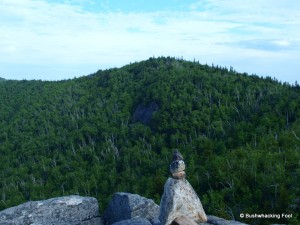
View from Jay Mountain ridge
Exploring Lot 8 was the primary impetus for visiting the Jay Mountain Wilderness Area, but a late start combined with a long drive left little margin for error. Add to the mix, dark clouds and high humidity, which portend an imminent threat of nasty weather and I end up with a do or die decision on whether to continue or turn around and search for a place to camp for the night.
After some hemming and hawing, the dwindling daylight hours and the threatening clouds tip the balance into retreat mode. The old expression “discretion is the better part of valor,” instantly comes to mind, combining with the notion of bushwhacking off the other side of Jay Mountain in increasingly dark conditions, not to mention finding a campsite with all its corresponding chores. Instead, I now find myself heading in the opposite direction down the trail and back in the direction from which I just came.
While crossing the ridge, my mind switches focus to all the steps necessary to get safely underneath the shelter of my tarp in the most efficient manner possible. Figuring out how I can still complete my trip with so little progress on the first day is a problem that must wait until tomorrow.
After twenty minutes at a fast pace, I find myself back at the intersection with just ten minutes until seven o’clock in the evening. Adding to the sense of desperation is the feeling of a hot spot on my right heel, requiring me to stop, remove my boot and cover the spot with duct tape for the descent down the trail.
My pace remains as quick as possible given the descent, with it only taking a half hour to reach the second stream where the potential for a campsite seems likely. After a quick search, most of the flat areas seem likely to pool water in a thunderstorm, so I am left with no other recourse but to set up the tarp in an area with a slight pitch down toward the stream. The waning daylight, now reduced by the tree cover, compels me to make the most of the site and find the least sloping location for my campsite.
Section Stats:
Date: June 17, 2014
Length: 2.0 miles (5.1 total daily miles; 5.1 total trip miles)
Difficulty: Easy
With the wind blowing the tree canopy to and fro above me, I set about doing my camp chores hurriedly using the last of the daylight to get as much done as possible. Filtering water, setting up my tarp, hanging the food rope and cooking up some hot dogs all gets done at a rapid pace as the last moments of the day recede into the early evening.
It is after nine before I finally crawl under the tarp for the night. The wind picks up as I write notes about the day’s adventure, with the sound of limbs crashing into each other keeping me on edge. A nearby dead limb creaks and cracks with the wind above me, filling me with feelings of trepidation and woe; perhaps this trip will end much sooner than I anticipated after all.
Sleep comes fitfully, interrupted occasionally by high winds, often becoming powerful gusts, and rain. The rain is never torrential, but when accompanied with thunder and lightning, it is disconcerting enough to keep me awake and increasingly nervous. Thunderstorms produce such a reaction ever since my ordeal with the microburst of the derecho storm in the Five Ponds Wilderness way back in 1995.
During one of those moments of lucidity and trepidation, I curse myself for setting up the tarp on an incline. As I try to pull myself upslope, still secured in my sleeping bag, I feel a strange wetness on the outside of my sleeping bag. With panic ensuing at finding my down sleeping bag wet during a rainstorm, I sit up in an attempt evaluate the situation.
“SPLOSH!”
Panic turns to outright terror when my hand feels totally submerged in water. What. The. Hell. Is. This. In my current half-conscious sleep state it takes a few moments to sink in. There is a puddle of water in my shelter!?! Sleepiness quickly turns into hysteria as my predicament coalesces into my now fully awake consciousness.
To my dismay, about an inch of water has accumulated in my insect netting shelter that I secure under my tarp. Apparently, the mostly mesh shelter slipped from underneath the tarp so that the rain ran right off the tarp and into my shelter, which apparently has a waterproof floor. Now I know what it feels like to sleep on a waterbed.
Waking up in an inch of water is never a good thing, especially when sleeping in a bag stuffed with hydrophobic goose down. Terror quickly turns into action, as I slink out of my sleeping bag, securing it on the upslope side of the tarp. I pull on the floor of my shelter just upslope from the large puddle, slowly moving the water toward the insect mesh where it can escape and do no further harm to my gear.
With the immediate threat of drowning in a puddle while sleeping no longer in play, it is time to fix the actual problem. After frantically donning my rain gear, I jump out from under the tarp and begin my attempt to remedy the situation. Pulling the shelter on the upslope side so it no longer protrudes out the other side of the tarp, I begin lowing the tarp on the downhill side all the way to the ground, thus preventing the damn shelter from slipping underneath any more. The entire time the rain keeps falling, whether it is from the soaked canopy over my head or the saturated clouds overhead, it is impossible to tell.
Hopefully, that will fix the problem. Unfortunately, there is no fixing the wet shelter floor, self-inflating air mattress, sleeping bag and all my other gear. Breaking out my two pack towels, I attempt to dry as much off as possible. This leaves everything damp, except for the towels which are now soaking wet. A quick wringing manages to get them to the same damp conditions as much of my gear, and myself.
Nothing short of a day with full sunshine and a dry wind is going help me with that. That will not happen until tomorrow at the earliest. It looks like it will be a damp night in the old shelter tonight.
Enjoy your wet night, sucker!
Affiliate Disclaimer: Some links within this blog post may send you to a retailer’s website. If you chose to purchase any product on that site, this author may receive a small commission at no extra cost you. These commissions provide compensation for the author’s time and effort necessary to provide the content at the Bushwhacking Fool.



